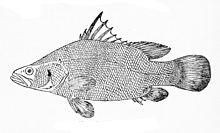Nile Perch
| Nile perch | |
|---|---|
 |
|
| Lates niloticus | |
| Scientific classification | |
| Kingdom: | Animalia |
| Phylum: | Chordata |
| Class: | Actinopterygii |
| Order: | Perciformes |
| Suborder: | Percoidei |
| Family: | Latidae |
| Genus: | Lates |
| Species: | L. niloticus |
| Binomial name | |
|
Lates niloticus (Linnaeus, 1758) |
|
| Synonyms | |
|
|
The Nile perch (Lates niloticus) is a species of freshwater fish in family Latidae of order Perciformes. It is widespread throughout much of the Afrotropic ecozone, being native to the Congo, Nile, Senegal, Niger, and Lake Chad, Volta, Lake Turkana, and other river basins. It also occurs in the brackish waters of Lake Maryut in Egypt. Originally described as Labrus niloticus, among the marine wrasses, the species has also been referred to as Centropomus niloticus. Common names include African snook, Victoria perch (a misleading trade name, as the species is not native to Lake Victoria), and a large number of local names in various African languages, such as the Luo name mbuta or mputa. In Tanzania, it is called sangara, sankara or chenku. In Francophone African countries, it is known as capitaine and in Egypt/Sudan as am'kal. Its name in the Hausa language is giwan ruwa, meaning "water elephant".
Lates niloticus is silver in colour with a blue tinge. It has distinctive dark-black eyes, with a bright-yellow outer ring. One of the largest freshwater fish, it reaches a maximum length of nearly 2 m (more than 6 ft), weighing up to 200 kg (440 lb). Mature fish average 121–137 cm (47.5–54 in), although many fish are caught before they can grow this large.
...
Wikipedia

